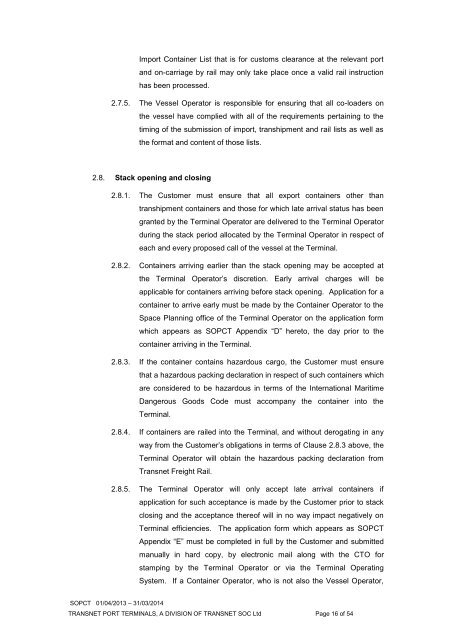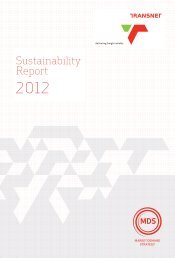Standard Operating Procedures for Container Terminals ... - Transnet
Standard Operating Procedures for Container Terminals ... - Transnet
Standard Operating Procedures for Container Terminals ... - Transnet
Create successful ePaper yourself
Turn your PDF publications into a flip-book with our unique Google optimized e-Paper software.
Import <strong>Container</strong> List that is <strong>for</strong> customs clearance at the relevant port<br />
and on-carriage by rail may only take place once a valid rail instruction<br />
has been processed.<br />
2.7.5. The Vessel Operator is responsible <strong>for</strong> ensuring that all co-loaders on<br />
the vessel have complied with all of the requirements pertaining to the<br />
timing of the submission of import, transhipment and rail lists as well as<br />
the <strong>for</strong>mat and content of those lists.<br />
2.8. Stack opening and closing<br />
2.8.1. The Customer must ensure that all export containers other than<br />
transhipment containers and those <strong>for</strong> which late arrival status has been<br />
granted by the Terminal Operator are delivered to the Terminal Operator<br />
during the stack period allocated by the Terminal Operator in respect of<br />
each and every proposed call of the vessel at the Terminal.<br />
2.8.2. <strong>Container</strong>s arriving earlier than the stack opening may be accepted at<br />
the Terminal Operator’s discretion. Early arrival charges will be<br />
applicable <strong>for</strong> containers arriving be<strong>for</strong>e stack opening. Application <strong>for</strong> a<br />
container to arrive early must be made by the <strong>Container</strong> Operator to the<br />
Space Planning office of the Terminal Operator on the application <strong>for</strong>m<br />
which appears as SOPCT Appendix “D” hereto, the day prior to the<br />
container arriving in the Terminal.<br />
2.8.3. If the container contains hazardous cargo, the Customer must ensure<br />
that a hazardous packing declaration in respect of such containers which<br />
are considered to be hazardous in terms of the International Maritime<br />
Dangerous Goods Code must accompany the container into the<br />
Terminal.<br />
2.8.4. If containers are railed into the Terminal, and without derogating in any<br />
way from the Customer’s obligations in terms of Clause 2.8.3 above, the<br />
Terminal Operator will obtain the hazardous packing declaration from<br />
<strong>Transnet</strong> Freight Rail.<br />
2.8.5. The Terminal Operator will only accept late arrival containers if<br />
application <strong>for</strong> such acceptance is made by the Customer prior to stack<br />
closing and the acceptance thereof will in no way impact negatively on<br />
Terminal efficiencies. The application <strong>for</strong>m which appears as SOPCT<br />
Appendix “E” must be completed in full by the Customer and submitted<br />
manually in hard copy, by electronic mail along with the CTO <strong>for</strong><br />
stamping by the Terminal Operator or via the Terminal <strong>Operating</strong><br />
System. If a <strong>Container</strong> Operator, who is not also the Vessel Operator,<br />
SOPCT 01/04/2013 – 31/03/2014<br />
TRANSNET PORT TERMINALS, A DIVISION OF TRANSNET SOC Ltd Page 16 of 54

















